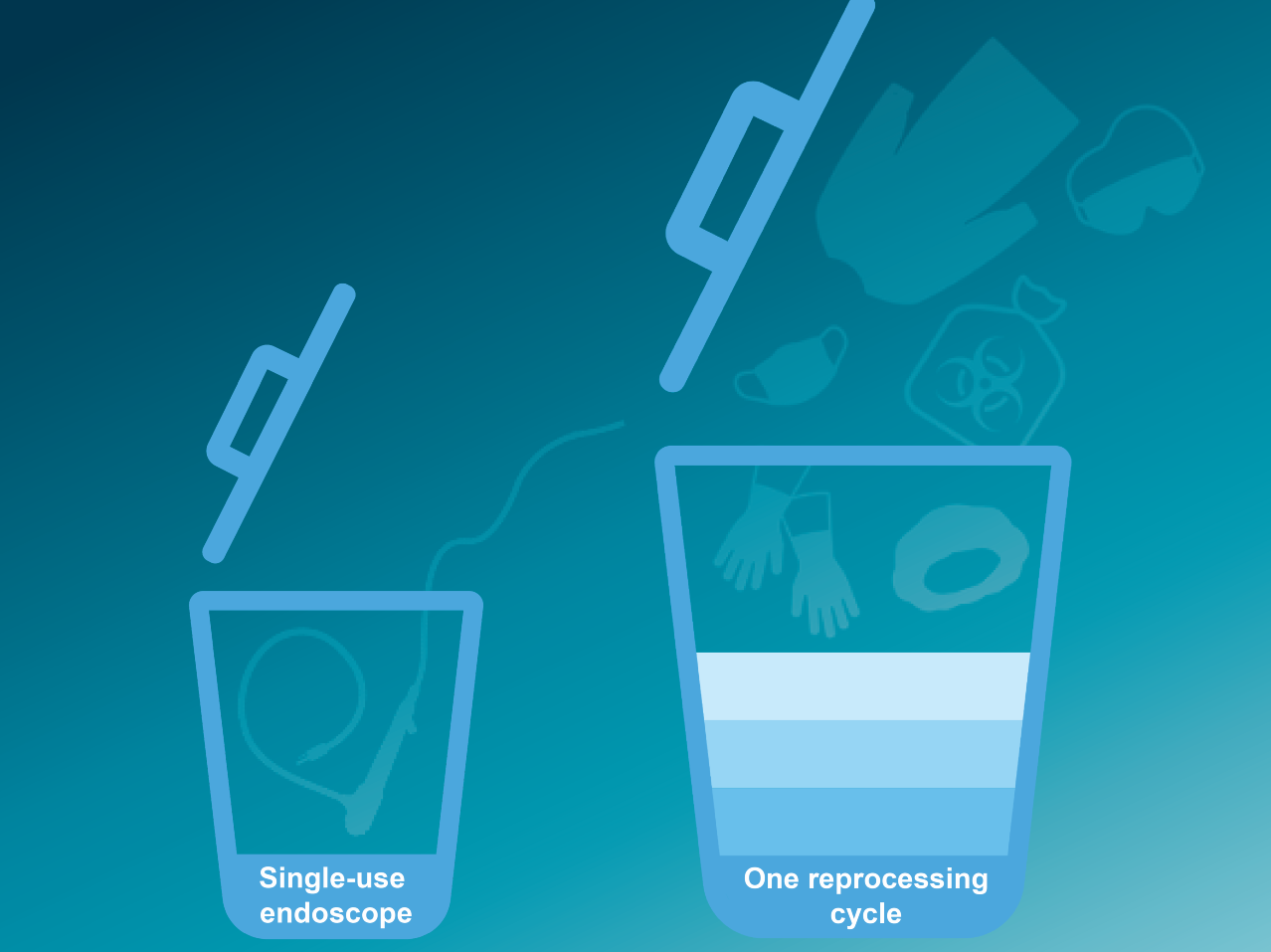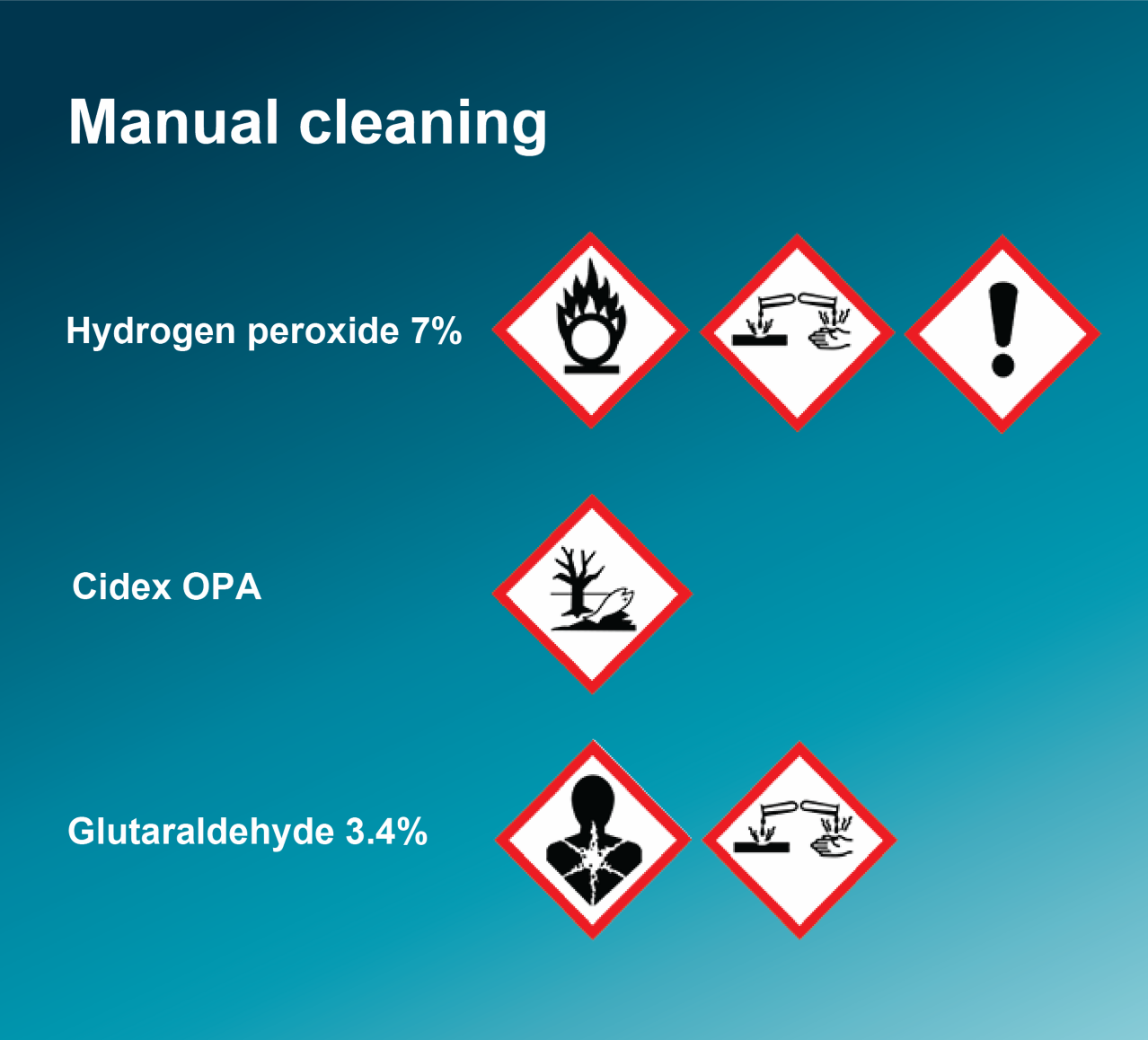Introducing bioplastics in our endoscopes
The world’s first endoscopes with bioplastic material
One tangible example of how we are paving the way in sustainability for single-use endoscopy is by introducing the use of bioplastics in our endoscope handles. This will start with Ambu® aScopeTM Gastro Large, and by 2025, we aim to use bioplastics in every endoscope handle we produce. While there will be no difference in the look, feel and performance of our endoscopes, the handles will be composed of material with a lower carbon footprint.
A more sustainable source of material
Bioplastics are made from second-generation bio-based feedstock mixed with fossil-based raw materials. Second-generation bio-based feedstock:
Reduces our carbon footprint
The ABS plastic used in the handles emits 70% less CO2 than handles made from purely fossil-based ABS plastic.* (Note that this reduction applies to the carbon footprint of the ABS plastic in the handle only, not the full lifecycle for the finished good.)
In the future, we will build on this initiative by expanding the use of bioplastics in other parts of our endoscopes. We will also work towards introducing bioplastic material with an even smaller carbon footprint.
*Based on cradle-to-gate LCAs on the raw material from the supplier. The LCAs compared ABS plastic made with 100% fossil-based feedstock with our new bioplastic ABS (which consists of 50% second-generation bio-based feedstock and 50% fossil-based feedstock).
For more information on our bioplastics initiative, read the FAQ.
Learn more about single-use endoscopes and the environment
Scroll down to learn how single-use endoscopy solutions compare with reusable ones in the area of sustainability and how we envision the future for the recycling of single-use endoscopes.
Have you considered the hidden waste associated with reprocessing?
It's true that single-use endoscopes are disposed of after each use. But it is important to consider that single-use endoscopes do not require reprocessing.
A multitude of single-use products are used for reprocessing
Single-use eliminates the energy consumed for reprocessing as well as the disposal of cleaning materials such as:
Chemicals and water
Brushes
Sponges
Cloths and personal protective equipment
While further research is needed to get a picture of the full life cycle, one study showed that the solid waste from one reprocessing cycle was four times heavier than the waste of one single-use cystoscope.1
The image shows the solid waste generated by one reprocessing cycle of reusable endoscopes. Single-use eliminates reprocessing and all the associated waste.

One reprocessing cycle
uses more water than a typical shower
Studies show that the amount of water used for one reprocessing cycle of a reusable bronchoscope uses 64 liters of water1-3, and for reusable cystoscopes, 60 liters of water are used.
The amount of water used for reprocessing a reusable bronchoscope and cystoscope, respectively, is more than the amount used in an average shower.1-3

The reprocessing of reusable endoscopes
involves hazardous gases
In addition to the impact on water quality, reprocessing's 100+ steps can involve gases and liquid chemical by-products of high-level disinfectants (such as o-Phthalaldehyde and glutaraldehyde) that can be hazardous and, in some cases, illegal when disposed of in sewers.4-6
Chemicals that are harmful to your staff and the environment


Chemicals used for reprocessing not only have a negative environmental impact, they can also cause asthma, dermatitis,
mucous membrane damage, and eye and skin damage for healthcare professionals.7
What do comparative studies say?
Single-use impact equal to or less than reusable in some cases
Three studies suggest that when everything is considered, the environmental impact of single-use ureteroscopes, bronchoscopes and cystoscopes is in fact equal to or less than that of their reusable counterparts. Further research is needed to determine the full life cycle impact.
Research shows great promise for the recycling of single-use endoscopes
A recyclability analysis of aScope 4 Broncho showed that, theoretically, this endoscope can be safely collected and disassembled and more than 85% of its weight can be recycled10.
While current regulations make the recycling of single-use endoscopes unfeasible due to medical risks, our long-term goal is recycling at scale in all focus markets by 2025.
Currently, we have a take-back and energy recovery partnership with Sharps in the U.S. and a take-back and recycling pilot project in Germany.
While we explore future possibilities for safe single-use endoscope processing and recycling, we're launching other initiatives. For example, we've partnered with Plastic Bank® to support the collection of ocean-bound plastic waste to offset the effect of our aScope endoscopes in EMEA and Latin America.
Learn about Ambu's environmental commitments, actions and partnerships.
Learn about Ambu single-use endoscopes for clinical areas
References
1. Tiphaine Boucheron, Eric Lechevallier, Bastien Gondran-Tellier, Floriane Michel, Cyrille Bastide, Nathalie Martin, and Michael Baboudjian.Cost and Environmental Impact of Disposable Flexible Cystoscopes Compared to Reusable Devices. Journal of Endourology. Oct 2022.1317-1321. https://doi.org/10.1016/j.purol.2021.08.067.
2. Birgitte Lilholt Sørensen, Henrik Grüttner. (2018) Comparative Study on Environmental Impacts of Reusable and Single-Use Bronchoscopes
3. Australia: https://www.mdba.gov.au/sites/default/files/water-volumes-teacher-notes.pdf (55L per shower)
EU: European Environment Agency https://www.oieau.org/eaudoc/system/files/documents/41/209216/209216_doc.pdf
US: Alliance for Water Efficiency: https://home-water-works.org/indoor-use/showers
4. https://www.civco.com/blog/how-to-dispose-of-high-level-disinfectants-safely
6. Program-wide Scope Reprocessing Competency Package, Kaiser Permanente, p. 41, https://studylib.net/doc/7338200/rinse%09flush
7. Walters 2019, SGNA 2013
8. Davis NF, et al. J Endourol. 2018 Mar;32(3):214-217. Carbon footprint in flexible ureteroscopy: a comparative study on the environmental impact of reusable and single-use ureteroscopes (Carbon Footprint in Flexible Ureteroscopy: A Comparative Study on the Environmental Impact of Reusable and Single-Use Ureteroscopes (s-icd.ca))
9. Baboudjian, et al., Life Cycle Assessment of Reusable and Disposable Cystoscopes: A Path to Greener Urological Procedures, Euro Uro Focus, 2022 Dec, Epub ahead of print
10. Recycling pilot project – data available upon request


